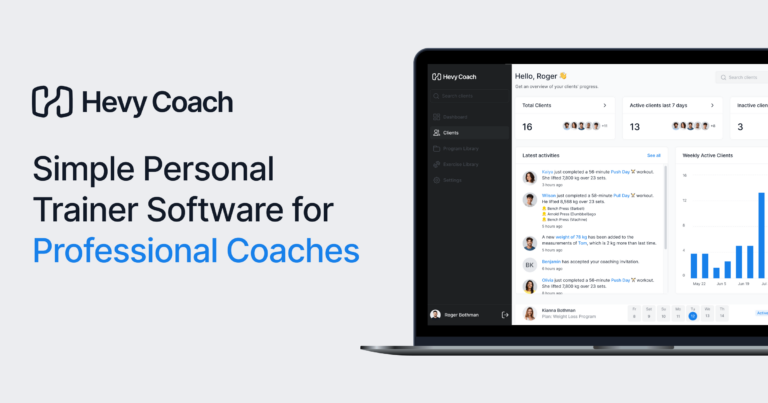Have you ever read something that evoked an emotion, brought you closer to someone, or made you take action? If so, you probably understand just how powerful a piece of writing can be.
As a coach or trainer, your bio is one of the most important things you must write.
The question is, how should you write a good bio? More importantly, what should it look like, and how long should it be? Let’s break it down.
What Is a Personal Trainer Bio?
A personal trainer bio is a short, clear, specific, and somewhat personal description of who you are, what you do, your accomplishments, and how you can help your clients.
It should include your name, a brief personal story, your credentials (e.g., NCSA-certified personal trainer), and what type of clients you primarily work with.
Why a Personal Trainer Biography is Important
The fitness industry is jam-packed with personal trainers and coaches, each looking to make a name for themselves. Because of that, rising above the noise is quite challenging.
One option is to carve out a small niche to attract people. For example, you can be the ‘exercise science’ guy or base your entire identity around a single exercise or training method, as some people have done.
But, regardless of your chosen approach, writing an excellent personal training bio will play a massive role in your success.
A great bio tells people who you are, makes you more relatable, and boosts your authority. In contrast, a lousy biography confuses potential clients by not telling them who you are, where you come from, or how you can help.
The key things a professional bio needs are specificity, clarity, and a personal story. Most personal trainer biographies lack one or more critical elements and are, therefore, not as impactful as they could be.
Why You Need a Personal Trainer Bio
A personal trainer bio doubles as a piece of information for people interested in learning who you are and as a subtle marketing message for the right clients.
For instance, if someone is a certified strength and conditioning coach primarily working with powerlifters and strength athletes, prospective clients instantly see if that person would fit their needs well.
A great personal trainer biography also provides the perfect opportunity for coaches to establish a connection with people and showcase their personalities. Depending on your comfort level, you could share personal information and inject humor to be more relatable.
Take Gil Mesina’s bio as an example. The first thing you notice is a photo of him holding his son, which instantly makes him more approachable, especially to parents who want to get fit.

Second, notice the language he uses. It’s casual; the text is written in the first person (I, me, my), and he writes:
“My passion is to help people change their lives in the simplest and most realistic way possible. I believe everyone deserves the right to good health and to be happy with themselves inside and out.”
This communicates that Gil is open to working with many types of clients and values the importance of fitness in the equation. More importantly, it lets people know that he is patient and understands that people have lives and cannot drop everything to get fit.
The goal isn’t to create a lifestyle centered on fitness but rather to integrate exercise and healthy eating into people’s lives in a way that complements everything else.

Try Hevy Coach
Intuitive personal trainer software, with a world class experience for your clients.
30 day free trial, no credit card required
Crafting an Effective Bio As a Personal Trainer
Crafting an excellent personal trainer bio can be challenging because it needs to be short and jam-packed with all the relevant information a client might be interested in.
You have two options for writing it:
- Write a lengthy bio and work backward, removing all the unnecessary and redundant information until you have something short and valuable
- Ponder over every single word you write and carefully put together concise sentences, only including the essential information
Let’s look at a few things to keep in mind:
Clarity and Specificity
You’re a unique person with knowledge, expertise, and experience, so it’s only natural to showcase them. After all, personal training clients won’t knock on your door and ask to work with you.
Before you write several pages, starting back from when you were in first grade and someone called you fat, stop and ask yourself:
- Is that information necessary?
- Am I clearly and explicitly telling future clients how I can help them?
- Do I come across as relatable?
Consider the following personal trainer bio examples:
- “I am a PN Certified Level 1 coach, currently working on Level 2. I am deeply passionate about helping people get fit and stay motivated on their fitness journey.”
- “I am a certified personal trainer specializing in developing simple and effective training routines for busy clients who can’t spend an hour at the gym several times per week.”
The first is short, which is excellent, but it doesn’t work well for two reasons. First, it is difficult to understand unless prospective clients know what that Level 1 certification means. Second, the bio is vague and doesn’t provide specific information on how this fitness trainer can help clients reach their goals.
The second bio is slightly longer, but you can instantly tell that it is more specific where it matters: telling future clients exactly what to expect.
The Length
There is no limit to how long to make your bio––it can be as long or as short as you want, so long as the reader gains some immediate insights:
- Who you are
- How you can help them
- What kind of a person you are
Do you consider yourself a wordsmith? Start with the most crucial info and follow up with an extended version of your bio. Don’t believe you are a good writer? Write a longer bio and slowly remove everything you deem unnecessary or distracting.
A shorter bio can keep the reader interested and encourage them to read the whole thing to learn who you are and how you can help.
What Information to Include
There isn’t a single best formula for what information to include in your personal trainer biography. Some folks include a story, and others don’t; some lean heavily on their credentials, and others talk about their coaching experience.
What matters most is that people quickly get an idea of:
- Who you are
- Where you come from
- How you can help them
It’s best to include the following:
- Your name
- A brief story of who you are, where you come from, and what struggles you’ve overcome
- What credentials and certifications do you have––college degree if relevant (exercise science, sports medicine, etc.), certifications, membership in professional organizations (e.g., NCSA), etc.
- Who your ideal client is, and how you help them reach their specific goals
The Personal Story
You’ve probably heard it a thousand times before, but it bears repeating: people love stories.
Exchanging stories is how we form bonds, get to know people, become more relatable, and share previous failures and successes.
A good personal story doesn’t have to be your entire life story. In fact, it’s much better to keep it concise and relevant because you wouldn’t want to bore a potential client to death.

It could be as short as one or two sentences. For instance:
“I was overweight and struggled with eating disorders for most of my life, but fitness has given me a purpose, helped me get in shape, and transformed my life. My mission is to share my knowledge and help others lead healthier and more fulfilling lives.”
Of course, that doesn’t mean you don’t have the right to share a longer version of your story with anyone interested.
For instance, you can set up a bio page in a way where the most important information is near the top, but readers have the option to dive deep if they want to know more.
You can also include client testimonials between some paragraphs to display social proof.
The Tone
Don’t write an uptight and overly professional bio in the third person (she, he, her, his, etc.). Instead, go for a laid-back approach.
When writing your bio, imagine you’re at a party, and a stranger asks what you do for a living. How you formulate your initial reply is how you should write your personal training biography.
You can make changes, add details, and polish your bio page later. The goal is to convey an authentic and honest persona, which engages people and makes them want to know more about you.
6 Personal Trainer Bio Templates to Write the Perfect Bio
1. Short and Sweet
I’m [Name], a [NASM, ISSA, etc.]-certified personal trainer who loves helping my clients achieve their goals and stop falling for misinformation. With [Number] of years in the field and [Credentials/Certifications], I’m here to help you.
My fitness journey began [Number] years ago in [City/province/country] when I [Personal story].
The experience taught me [Some key takeaways] and led me to become a personal trainer.
Today, I [Share a bit about what you do now, what types of clients you help, etc.]. So, reach out, and let’s chat about your goals and how I can help.
[Insert your call-to-action here].
2. More Info On the Coaching Process
My name is [Name], and I’m a certified personal trainer dedicated to providing personalized training plans that take my client’s schedules, goals, preferences, limitations, and experience in mind.
I’ve been a coach since [Year] and have worked with [Rough estimate] of clients, helping them [Specify in what ways you’ve helped clients].
My coaching process involves [Describe your coaching process and give specific details], ensuring that each workout is productive and aligns with your goals.
I have certifications in [List of certifications/credentials], and I’m here to help you [List some specific goals].
[Insert your call-to-action here].

Try Hevy Coach
Intuitive personal trainer software, with a world class experience for your clients.
30 day free trial, no credit card required
3. More Info On Who You Can Help
I’m [Name]––a [Organization]-certified personal trainer with [Number] years of experience helping people [List specific things you help clients achieve].
It all started in [Year] when I first started working as a trainer in [Where: city, specific gym, etc.], helping people [List things you helped people at first]. These experiences taught me that [List some lessons you’ve learned] and helped me [List some specific ways in which those experiences helped you become a better coach].
Since then, I’ve worked [Explain where, for how long, and what types of clients you’ve helped].
My approach is [Explain a bit about your approach, how you determine who you can help, and other relevant details].
One thing I’ve learned about [Describe a specific type of client you can help] is that [What you’ve discovered]. This unique insight helps me [List some ways it helps you and sets you apart from other personal trainers].
[Insert your call-to-action here].
4. Friendly and Approachable
Hello there! My name is [Name]––your friendly neighborhood personal trainer. I believe that fitness should be fun and accessible to everyone, everywhere.
As a trainer, I’ve encountered countless people and noticed a similarity: [Explain something you’ve learned and how it could make you appear more friendly]. Because of that, I’ve dedicated myself to helping [Describe a specific type of client] reach their fitness goals through [Describe your process a bit].
More specifically, I [Further elaborate on your coaching process]. [Perhaps include a short and humorous story about your fitness journey or from your coaching experience].
My goal is to help everyone feel welcome and, more importantly, look forward to each workout. I understand how scary it can be to get started, so my number one priority is to help you reach that next milestone––be it to squat 300 lbs or do three push-ups. I’m here to help.
[Insert your call-to-action here].
5. Lean On Experience
I’m [Name]––a [Certified PT, CSCS, Nutritionist, etc.] with [Number] years of experience coaching [Briefly explain what types of clients you’ve helped].
As a coach, I’ve [Further elaborate on how you’ve helped people]. One time, I [Include a brief story or anecdote; make it humorous].
I’ve also [Discuss how you help people or have helped a specific individual].
With [List certifications and degrees], I bring knowledge and experience to optimize your training sessions, so you don’t have to worry about a thing.
[Insert your call-to-action here].
6. Emphasize Personalization
Hi, I’m [Name], a [Organization] certified personal trainer who believes that every client needs (and deserves) a unique plan that fits their needs, life circumstances, and preferences.
As a coach, I see how cookie-cutter solutions get promoted constantly, and I’m not happy about it. Why? Because you are unique and your workout plan needs to be tailored to your needs.
Back in the day, [Include a short story or observation that aligns with the topic of personalization; maybe something that inspired you].
Because of that, I have made it my mission to [Briefly describe how you want to help]. My goal is to create a training plan that fits you like a tailored suit.
What is it like to work with me? [Briefly explain your process and how you personalize training plans].
[Insert your call-to-action here].
5 Tips for Nailing Your Bio Page Perfectly
1. It’s Not About You
A good bio clarifies how you can help a prospective client. Be clear and specific.
For example:
“As someone who struggled with weight loss for years, I’ve experienced most of the challenges first-hand. My experience allows me to develop simple and sustainable exercise plans that take my client’s goals, needs, preferences, and schedule into consideration.”
You share information about yourself, but you present it in a way that tells people how you can help them.
2. Include a High-Quality Photo
No good personal trainer biography is complete without a high-quality, relevant photo. A good picture amplifies the bio and showcases the trainer’s passion for health and fitness.
Ideally, the photo should be of you wearing a big smile in a fitness setting. For example, if you run a personal training business, the photo could be of you at the gym, training a client, and having a good time.
3. Tell Your Story Right
A good story doesn’t have to be long. Touch on your starting point, mention some of your failures and setbacks, and share your success before moving on.
4. Write in the First Person
As mentioned numerous times already, the goal of a good bio is to impact people and make you relatable. A straightforward way to accomplish that is to write in the first person (I, me, we, us, etc.) and address potential clients directly (“you”).
5. Conclude with a Call to Action (CTA)
You’ve written a good bio and uploaded a great photo, but how do you conclude the whole thing? By telling the reader what they should do next.
Should the person call, email you, or contact your gym’s reception desk to book an appointment? Or maybe you’ve put together a quiz for potential clients and want them to take it?
Whatever it is, conclude the bio with a friendly, bold call to action.
Personal Trainer Biography Examples
Example 1: Martin Bugaj
Martin has done an excellent job sharing information on who he is and how he can help clients. He’s also included a relevant photo that further displays his expertise.
The only thing he could have done better is to write it in first person.
Example 2: Andria & Greg
Andria and Greg also do a great job sharing about themselves, displaying their expertise, and telling potential clients how they can help.
Both have included relevant photos, and their biographies aren’t overly long.
Example 3: Gilberto Antonino Mesina
Gil’s bio is longer, but it works well because he immediately looks approachable and friendly. He also displays his certifications right away without spending unnecessary words on them.
One thing he could have done better is to modify the first couple of paragraphs, include a call to action, and then proceed with the rest of the information. You can check out the whole page here.
Common Mistakes to Avoid in Your Personal Trainer Biography
1. Writing in the Third Person
Writing the bio in the third person isn’t a fatal mistake. Still, it makes the text more formal, which can make you seem less relatable.
2. Low-Quality Photo
As mentioned above, a good photo can elevate the bio and make it much more impactful. In contrast, a low-quality or irrelevant photo can hinder the biography and make potential clients less likely to engage.
The worst thing you can do is not include a photo at all.
3. Me, Me, Me
The third common error to be mindful of is making the bio all about you. Sure, you must tell people who you are, what you do, and how you can help, but it can’t revolve around you.
People will read your bio to know if you can help them and if you’re a good person to work with.
4. Making it too Long
A long bio increases the risk of losing the reader’s interest. So, keep it tight and specific.
You can always share additional information about your credentials, experience, life story, fitness journey, etc., but begin with a concise bio and a clear call to action.
5. Being Vague
Supporting clients on their fitness journey and encouraging beginners to step out of their comfort zone sounds nice, but it doesn’t say much.
Remove all vague statements from your bio and replace them with actionable and specific ways in which you can help people. Don’t be afraid to get clear and create a niche for yourself.
For example:
“I support clients on their fitness journey.” ⇒ “I create simple and sustainable training programs for overweight adults.”

Try Hevy Coach
Intuitive personal trainer software, with a world class experience for your clients.
30 day free trial, no credit card required
6. No Call to Action
You can see it everywhere:
A great bio that hits all the marks, only to end abruptly and leave the person wondering what they should do next or how to contact the trainer.
You should always conclude with a call to action because the objective of a good bio is to spark interest and attract new clients.
Final Words
Crafting a unique bio is immensely valuable for your personal training business. When done right, it sets you apart, makes you more approachable, and tells people who you are, where you come from, and how you can help them.
Hopefully, the above personal trainer biography examples give you some ideas on tackling yours. Remember:
While using a template for inspiration is great, you should try to write something unique. Nobody else has had the exact experiences as you, so use that to your advantage to tell the world why you’re the personal trainer they need.
If you want to differentiate yourself from the competition further, consider a coaching platform like Hevy Coach. With it, you can create training programs quickly, assign them to clients, and track their progress from a single dashboard. Doing so streamlines the coaching experience, saving you and your clients time and effort.
Whether you coach people in person or online, having a simple way to track how they are doing and answer their questions will help you in the long run.
FAQs
1. How long should my personal trainer bio be?
There isn’t a single perfect personal trainer bio. A shorter one tends to be better for keeping people interested, but don’t be afraid to write something longer so long as it tells people who you are, explains how you can help, and makes you more approachable.
2. What details should I include in my personal trainer bio?
Explain who you are and how you got into fitness. Mention your certifications, discuss your experiences, and explain how you can help potential clients. The goal is to inform people and subtly market yourself.
3. Should I include a photo in my bio?
Adding a high-quality photo, preferably of you coaching someone in a gym setting, builds trust, makes you appear more professional, and helps you stand out.




